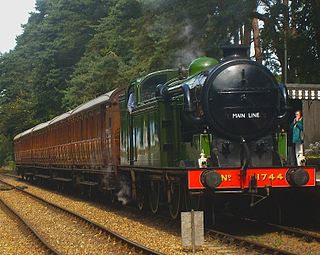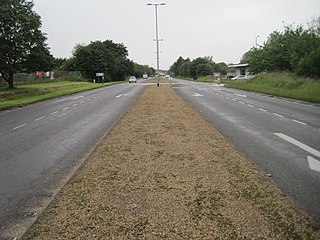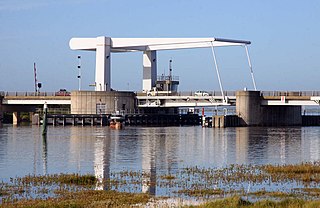
The North Norfolk Railway (NNR) – also known as the "Poppy Line" – is a 5+1⁄4-mile (8.4 km) heritage steam railway in Norfolk, England, running between the towns of Sheringham and Holt. The North Norfolk Railway is owned and operated as a public limited company, originally called Central Norfolk Enterprises Limited. The railway is listed as exempt from the UK Railways (Interoperability) Regulations 2000.

Great Yarmouth, often called Yarmouth, is a seaside town which gives its name to the wider Borough of Great Yarmouth in Norfolk, England; it straddles the River Yare and is located 20 miles (32 km) east of Norwich. Its fishing industry, mainly for herring, shrank after the mid-20th century and has all but ended. North Sea oil from the 1960s supplied an oil-rig industry that services offshore natural gas rigs; more recently, offshore wind power and other renewable energy industries have ensued.

Berney Arms is a settlement on the north bank of the River Yare, close to Breydon Water in the English county of Norfolk. It is part of the civil parish of Reedham, in the district of Broadland, and lies within The Broads. It comprises a railway station, a windmill, a farmhouse and a pub which closed in late 2015. In 2020, an adjacent property opened as a bistro. The area is not accessible by public road.

The River Yare is a river in the English county of Norfolk. In its lower reaches it is one of the principal navigable waterways of The Broads and connects with the rest of the network.

The A47 is a major trunk road in England linking Birmingham to Lowestoft, Suffolk, maintained and operated by National Highways. Most of the section between Birmingham and Nuneaton is now classified as the B4114. From Peterborough eastwards, it is a trunk road.

The Midland and Great Northern Joint Railway (M&GNJR) was a railway network in England, in the area connecting southern Lincolnshire, the Isle of Ely and north Norfolk. It developed from several local independent concerns and was incorporated in 1893. It was jointly owned by the Midland Railway and the Great Northern Railway, and those companies had long sponsored and operated the predecessor companies.

Berney Arms railway station is on the Wherry Lines in the East of England, serving the settlement of Berney Arms on the Halvergate Marshes in Norfolk. It is located 15 miles 71 chains (25.6 km) east of Norwich and is the only station on a short stretch of single line between Reedham and Great Yarmouth. The station is managed by Greater Anglia, which also operates all trains serving it.

Great Yarmouth railway station is one of two eastern termini of the Wherry Lines in the East of England, serving the seaside town of Great Yarmouth, Norfolk. The other terminus at the eastern end of the lines is Lowestoft and the western terminus, to which all trains run, is Norwich.

Wherryman's Way is a long-distance footpath in the English county of Norfolk.

Whitwell and Reepham railway station, also known as Whitwell station, is a former station situated in Norfolk, England. The station closed in 1959 and is a notable stop on the Marriott's Way long-distance footpath. It is being restored as a railway museum, including the re-laying of track.

William Marriott was the engineer, locomotive superintendent and traffic manager of the Midland & Great Northern Joint Railway (M&GN)

Melton Constable was a railway station on the Midland and Great Northern Railway which served the North Norfolk village of Melton Constable from 1882 to 1964. Notwithstanding its rural location, the station became an important railway centre with lines converging from all directions providing connections to key East Anglian towns such as King's Lynn, Norwich, Cromer, Fakenham, Yarmouth and Lowestoft. Although long since demolished, there is a possibility that the station may yet be resurrected as part of the proposed Norfolk Orbital Railway.
Newtown Halt was a railway station on the Midland and Great Northern Joint Railway (M&GN) which served the northern part of Great Yarmouth in Norfolk, England. Opened in 1933, it was closed as a wartime economy measure and reopened in 1948 only to last a further eleven years before closing with the line.

Holt railway station served the town of Holt in Norfolk, England. It was part of the Midland and Great Northern Joint Railway network, which spread over much of East Anglia, providing connections to Cromer, Norwich and Yarmouth. The station was closed in 1964 and the site is now occupied by a main road. There are proposals to rebuild the line through the town, as part of an orbital railway scheme, and possibly a new station to serve the town.

Alexander Ross was a British civil engineer particularly noted for his work with the railway industry.

The East Norfolk Railway was a pre-grouping railway company operating a standard gauge 25 mile, mostly single track, railway running between Norwich Thorpe railway station and Cromer in the English county of Norfolk. It opened in 1874, reaching Cromer three years later, and remains mostly operational. The company also operated a branch between Wroxham and County School, which closed to passengers in 1952, and had proposed a branch to Blakeney in 1878, which was never constructed.

Melton Constable railway works was a railway maintenance and production facility on the Midland and Great Northern Railway. The buildings and operations in the village of Melton Constable from 1883 to 1964 were vital to the village economy and indeed it is known that the village itself was created to house the employees who worked there. The works are known by many as the 'Crewe of North Norfolk' as Crewe was similar to Melton Constable, although on a much larger scale. Since the loss of the works and rail links the village has never recovered to pre World War I levels.
The Yarmouth–Lowestoft line was an East Anglian railway line which linked the coastal towns of Yarmouth, Gorleston-on-Sea and Lowestoft. It opened on 13 July 1903 as the first direct railway link between the two towns and was constructed by the Great Eastern Railway and the Midland and Great Northern Railway in the hope of encouraging the development of holiday resorts along the coast. In the event, although the line was built to high standards and considerable cost, intermediate traffic did not develop and competition from buses and trams eroded the little that had been generated. Fish traffic was carried in large quantities until the 1930s when it fell into decline. In 1953, when major repairs to the Breydon Viaduct were required, it was decided to discontinue through services from the Midland and Great Northern to Lowestoft and to divert London trains to Lowestoft via Norwich. After the Midland and Great Northern and Yarmouth–Beccles line closed to passengers in 1959, the Yarmouth–Lowestoft line was upgraded to accommodate the diverted traffic, but after services were switched to Yarmouth Vauxhall in 1962, it was singled and the stations made unstaffed halts. With only a local service running between vandalised stations, the decision was taken to close the route on 4 May 1970 in favour of bus services which were judged adequate for most of the year.
The Eastern and Midlands Railway was formed in 1881 by the amalgamation of several small railways in the Isle of Ely, Cambridgeshire, Lincolnshire and Norfolk, England, including the Yarmouth and North Norfolk Railway, the Lynn and Fakenham Railway and the Yarmouth Union Railway. Many of these lines were built by contractors Wilkinson and Jarvis. In 1893 the Eastern and Midlands Railway became part of the Midland and Great Northern Joint Railway.

The Breydon Bridge is a single-span drawbridge carrying the A47 in Great Yarmouth across the River Yare close to Breydon Water. It replaces the former railway Breydon Viaduct which was closed in 1953 and demolished by 1963. Completed in 1985, an average of 31,000 vehicles cross the bridge each day.



















